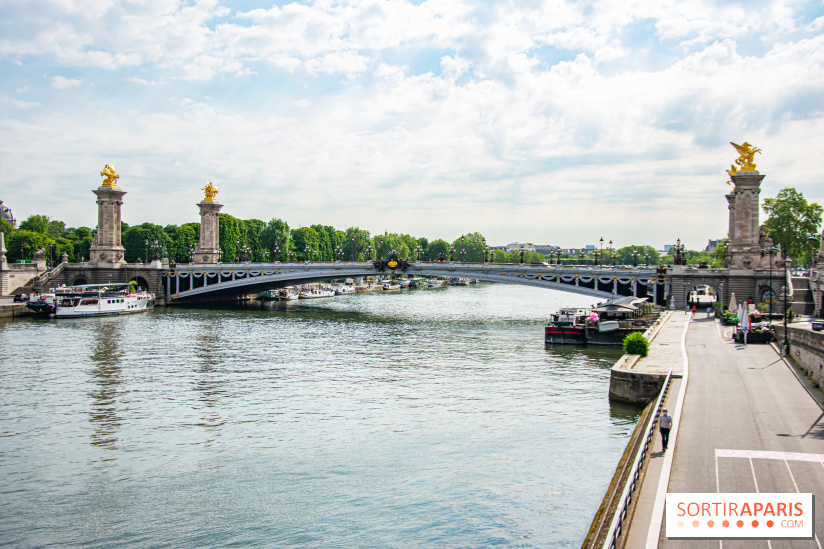Due to the installation of several temporary competition sites linked to this summer's Olympic Games, the City of Paris has announced a series of upcoming disruptions for pedestrians, cyclists and motorists. Find out more about the traffic restrictions and installation dates for these temporary sites in the capital.
Seven of them. Seven temporary sites, six of them dedicated to competitions, soon to be set up in three central areas of the capital for the Paris Olympic and Paralympic Games. In detail, these temporary sites are to be set up near the Eiffel Tower, the Champ-de-Mars, the esplanade des Invalides, the Alexandre III Bridge and the Place de la Concorde.



 Paris 2024 Games: all the Paralympic venues in Paris and the Île-de-France region
Paris 2024 Games: all the Paralympic venues in Paris and the Île-de-France region
Where are the Paralympic venues for these Paris 2024 Games? Find the complete map of future events in the capital and Ile-de-France, and discover all the places of interest in the competition! [Read more]
These ephemeral sites also require a certain amount of time to set up, before the Games, and dismantle, after the Games. The City of Paris is therefore announcing traffic restrictions over the coming weeks, disrupting the daily lives of pedestrians, cyclists and motorists passing through these areas. Discover now the detailed schedule for the set-up and dismantling of the 5 sites located in the center of the capital.




Concorde zone
- March 1: Installation begins on the east side of Place de la Concorde
- Progressive extension of the worksite over the entire Place de la Concorde from March 1 to June 1
- April 1: south-west quarter of the square
- April 26: traffic closure: (pedestrians/bicycles/vehicles) on the Cours de la Reine between avenue Winston-Churchill and avenue Franklin-D-Roosevelt
- May 17: north-south axis closed to traffic (pedestrians/cycles/vehicles)
- June 1: closure to vehicular, pedestrian and cycle traffic of the entire Place de la Concorde
- July 1: closure of the Pont du Carrousel to vehicular traffic
- July 15: Pont Royal closed to vehicular traffic
- August 29 to October 30: gradual freeing of the right-of-way on Place de la Concorde
- September 7: partial reopening to traffic (west side alley)
- September 25: reopening of the western part of the square
- October 30: release of the eastern part of the square




Trocadéro - Eiffel - Champ-de-Mars zone
Champ-de-Mars zone
- March 4: Installation begins in Place Jacques-Rueff and Avenue Joseph-Boulard (closed to vehicles and pedestrians).
- Gradual extension of the worksite to all Champ-de-Mars gardens from March 4 to July 1
- April 12: closure of Place Gouraud and extension into the garden
- June 3: almost complete closure of the Champ-de-Mars gardens
- July 1: Pont d'Iéna closed to vehicular traffic
- July 24: closure to traffic (surface vehicles) of quai Jacques-Chirac
- Gradual liberation of the site from September 19:
- October 7: liberation of most of the site, except around Place Jacques-Rueff
- November 4: total liberation of the site
Trocadero zone
- March 20: assembly begins via Place de Varsovie, with the northern part of the square closed to traffic
One-way traffic on Avenue des Nations-Unies, with the area around the fountain closed to pedestrians.
- Gradual closure of the Trocadéro gardens from March 20 to July 1
- May 1: Traffic reduced to one lane in each direction on avenue du Président-Wilson and closure of the southbound carriageway of place du Trocadéro
- June 10: closure of avenue des Nations-Unies to traffic (including pedestrians)
- July 1: closure of the Trocadéro gardens and closure to traffic (vehicles, pedestrians and bicycles) of avenue Albert-de-Mun and avenue Wilson south (between Albert-de-Mun and place d'Iéna)
- July 16: closure of Place du Trocadéro and Pont d'Iéna (motor vehicles, pedestrians and bicycles)
- July 21: closure to cars of quai Jacques-Chirac (between avenues Suffren and Bourdonnais), with the underground section remaining open to traffic.
- July 27 to October 8: gradual release of the right-of-way
- July 27: Place du Trocadéro
- August 12: Pont d'Iéna and Quai Jacques-Chirac
- September 7: Place de Varsovie and Avenue des Nations-Unies
- September 15: avenue Wilson
- September 19: most of the Trocadéro gardens
- October 8: total liberation of the site




Grand Palais - Pont Alexandre-III - Invalides area
Invalides area
- April 12: installation begins on the south-east lawns of Place des Invalides, and rue Saint-Dominique between avenue Gallieni and rue de Constantine, and between rue Fabert and rue Constantine, isclosed to traffic.
- Gradual extension of the worksite to all the Invalides lawns and avenue du Maréchal-Gallieni from April 12 to June 17
- May 1: installation on the south-west lawns
- May 17: closure of avenue Gallieni
- May 30: closure of the Bleuet-de-France traffic circle and one-way traffic on rue de Grenelle
- June 17: closure of rue de l'Université between Fabert and Constantine
- From September 18 to October 30: gradual freeing of spaces
- September 18: reopening of rue de l'Université
- September 25: reopening of avenue Gallieni and the Bleuet-de-France traffic circle
- October 16: release of the south-west lawn and reopening of rue Saint-Dominique between Fabert and Gallieni
- October 30: complete reopening of rue Saint-Dominique and complete liberation of the site
Grand Palais - Alexandre-III area
- April 26: start of assembly work on the Cours La-Reine (closed between the Invalides and Alexandre-III bridges)
- April 26 to June 10: gradual extension to the entire area
- May 17: closure of the Alexandre-III bridge to vehicular traffic (pedestrian traffic maintained on the upstream sidewalk)
- May 20: closure of the Champs-Élysées port
- June 3: closure of the Invalides port for assembly (until June 10).
- September 12 to October 26: gradual vacating of the right-of-way, including opening of the Alexandre-III bridge on September 20
- September 30: dismantling of installations on the Port des Invalides
- October 15: opening of the Cours La-Reine and freeing of the Champs-Élysées port
We would also like to remind you that the Paris Prefecture of Police will be setting up security perimeters around the competition sites during the Olympic Games.



 Paris 2024 Olympics: a special certificate to drive around Paris during the Games
Paris 2024 Olympics: a special certificate to drive around Paris during the Games
QR codes, credentials, protection zones: during the Paris 2024 Olympic and Paralympic Games, it will be difficult to drive around the capital. Here are the main elements of the security plan, presented by Laurent Nuñez, Prefect of Police. [Read more]
Public transport will also be disrupted during the Olympic Games, with several metro stations to be avoided and others closed.



 Paris 2024 Olympics: transport lines and metro stations to avoid
Paris 2024 Olympics: transport lines and metro stations to avoid
With the Paris 2024 Olympic and Paralympic Games just around the corner, many Parisians are worried about public transport ridership. The government has just launched the "anticiperlesjeux.gouv.fr" information website, and you can find out which metro, tramway, RER and Transilien lines will be most affected during the Paris Olympics. Several metro stations will also have to be avoided, while others will be closed to passengers. [Read more]
Paris 2024 Games: all the Paralympic venues in Paris and the Île-de-France region








Paris 2024 Olympics: a special certificate to drive around Paris during the Games
Paris 2024 Olympics: transport lines and metro stations to avoid